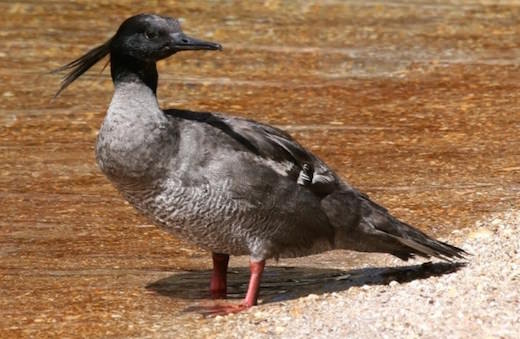Brazilian merganser

Critically endangered
A duck of slender proportion and a dark color, it’s got a particularly long crest which tends to be a little bit shorter when you are talking about a female merganser. The upper body of these creatures tends to be dark grey, whilst the breast is a light grey color in contrast. One of the most striking things about these creatures, however, is the fact that they are mostly silent – when they do make noise, it almost sounds like a dogs bark rather than the traditional quack you would expect to hear from a duck.
This contributes to their rather comical image among some Brazilians. However, their plight as a species is no laughing matter – it’s estimated that less than 250 of these birds are left in the world. They are in danger to such a scale that very little is even known about their traditional breeding techniques and style.
Population Distribution
As mentioned above, less than 250 of these birds are left. They came from a central and southern Brazilian region, and eventually fell into nearby regions of both Argentina and Paraguay. However, the populations confirmed to remain are all to be seen in Brazil as none have been reported in Argentina for quite some time – reports are scarce in 2015.
Their main distribution location seems to be within Serra da Canastra, where just under a fifth of the remaining population all remain. The last recorded ducks within Argentina, for example, were in 2002 when they were found within the Misiones. Other than this, the animals are very much rare to be seen across the world as they have been ravaged by various different reasons. Their habitats are diversely spread out as well, meaning that close interaction between groups of the merganser are no longer possible, which has contributed to their current state.
Threats
The most common threat to these ducks is down to humans, believe it or not. As industry and agriculture has expanded, their habitats have become smaller and been degraded. Water has also become more toxic, and this has been a serious contributor to their massive demise.
Soil erosion and deforestation play a part too, however. Dam-building has been another key killer for these creatures, as they have been eradicating small rivers and turning them into massive lakes which aren’t suitable for the ducks. Pesticides are one of the main killers as well, contributing to their measly number remaining.